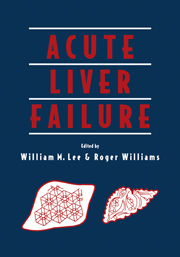Book contents
- Frontmatter
- Contents
- Preface
- Foreword
- Acknowledgments
- Contributors
- Part One Clinical Syndrome and Etiology
- Part Two Mechanisms of Disease and Multisystem Involvement
- Part Three Intensive Care Management
- Part Four Transplantation
- Part Five Artificial and Bioartificial Liver Devices
- Part Six Other Applications
- 21 Treatment of acute liver failure by high volume plasmapheresis
- 22 Dialysis/adsorption techniques for acute liver failure
- 23 Hepatocyte transplantation in liver failure and inherited metabolic disorders
- Index
- Plate section
21 - Treatment of acute liver failure by high volume plasmapheresis
from Part Six - Other Applications
Published online by Cambridge University Press: 20 May 2010
- Frontmatter
- Contents
- Preface
- Foreword
- Acknowledgments
- Contributors
- Part One Clinical Syndrome and Etiology
- Part Two Mechanisms of Disease and Multisystem Involvement
- Part Three Intensive Care Management
- Part Four Transplantation
- Part Five Artificial and Bioartificial Liver Devices
- Part Six Other Applications
- 21 Treatment of acute liver failure by high volume plasmapheresis
- 22 Dialysis/adsorption techniques for acute liver failure
- 23 Hepatocyte transplantation in liver failure and inherited metabolic disorders
- Index
- Plate section
Summary
INTRODUCTION
When ammonia intoxication was believed to be the dominant cause of hepatic encephalopathy, and hemodialysis was introduced for treatment of renal failure, the idea of dialyzing patients with hepatic failure seemed obvious (Kiley et al. 1956). When hemodialysis proved to have little or no effect on hepatic encephalopathy, it became apparent that encephalopathy is not caused by high blood concentrations of dialyzable substances.
Other possible causal mechanisms would include an accumulation of harmful non-dialyzable substances (the intoxication concept) or a lack of production of compounds essential for cerebral metabolism (the fallout concept). The intoxication concept remains the more popular one, probably because of the analogy to renal failure.
Discrimination between these possibilities has not been possible so far. Instead, attempts have been made to develop support systems combining both concepts. Several systems have been tried including exchange blood transfusion, plasmapheresis, and the most complete system, perfusion of the patient's blood through an extracorporeal liver. No liver support system to date (except orthotopic liver transplantation) has demonstrated convincing and reproducible beneficial effects. Possible explanations for the limited success with support systems include that the procedures mainly have been used in cases with irreversible brain damage, or that they have been quantitatively insufficient. In the latter case the solution might be to increase the capacity of the system being used.
PLASMAPHERESIS
Plasmapheresis satisfies the condition of both removing potentially toxic compounds from the blood, independent of molecular weight (unless they are bound to blood cells), and of providing required compounds from healthy subjects (unless they are short-lived).
- Type
- Chapter
- Information
- Acute Liver Failure , pp. 267 - 277Publisher: Cambridge University PressPrint publication year: 1996



